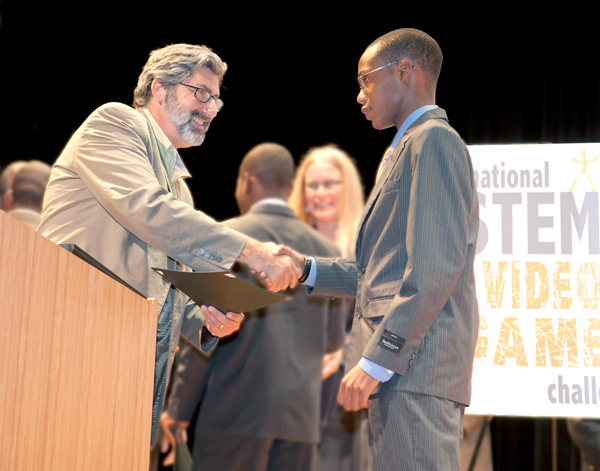
Washington DC high school student Golden Rockefeller (right)
was a 2012 STEM Video Game Challenge winner for a game called Electrobob.
Photo courtesy of E-LIne Media.
Students are invited to enter the annual National STEM Video Game Challenge, and organizers are hoping school librarians will help mentor and support kids throughout the process.
In its third year, the contest welcomes students in grades 5–12, including homeschoolers, to create a video game, incorporating science, technology, engineering, and mathematics (STEM) skills into their design. Organizers E-Line Media and the Joan Ganz Cooney Center at Sesame Workshop partnered this year with the Institute of Museum and Library Services (IMLS) to extend their outreach to museums and libraries, including K–12 school libraries.
“The more librarians, the better,” says Christa Avampato, a consultant at the Sesame Workshop working directly on the challenge. “A school library is really a hub of a school, where a lot of workshops, knowledge, and socializing takes place. So a librarian becomes more of a mentor with the kids and, as such, has the opportunity to develop interest in the challenge.”
Getting students excited about STEM subjects is precisely why organizers launched the Challenge three years ago, says Brian Alspach, executive vice president of the New York-based game publisher E-Line Media. And video game design seemed the perfect vehicle. Not only do kids like to play them, but many have also experimented with making their own games using programs such as MIT’s Scratch and Microsoft’s Kodu, which are freely available online. (Students can use these programming languages, among others, to create STEM Challenge entries.)
“When you connect to the interest of a young person, that creates a really powerful environment for learning,” says Alspach. “The concept of kids doing something they enjoy is what we’re trying to instill with the STEM challenge.”
Last year’s winners included the Darwin’s Finches game by Steven Stulga. Winner of the High School Open Platform category, the game turns players into species of birds from the Galapagos Islands, and they learn about natural selection. Owen Leddy’s Pathogen Wars, which took the top prize in the High School Playable Game category, had players traveling through the human immune system.
Students—as well as librarians, teachers, parents, or any adult hoping to mentor an entrant—can take advantage of several in-person events taking place across the country in the next two months. On the Challenge site, a Mentor Resource Kit is available for download, with ideas on how to create your own related workshops, and a webinar is in the works. Marsha Semmel, director of strategic partnerships at IMLS, says the sponsors are hoping to push the contest into more public and school libraries to take advantage of the kind of education taking place in these centers.
“We wanted to highlight the fact that a library, any kind of library, is a good place to teach and learn about gaming,” she says. “We want to promote libraries as effective areas of learning.”
Students can enter in either the middle school or high school categories, depending on their age, and can submit a game on their own or as a team of up to four members. Prizes include an AMD laptop fully stocked with game-making software, a $2,000 cash prize for their winning school, plus a visit to New York City to pick up their award. Registration opened in February, and students have until April 24 to submit their finished entry—just enough time to get your students’ game face on and start coding.


